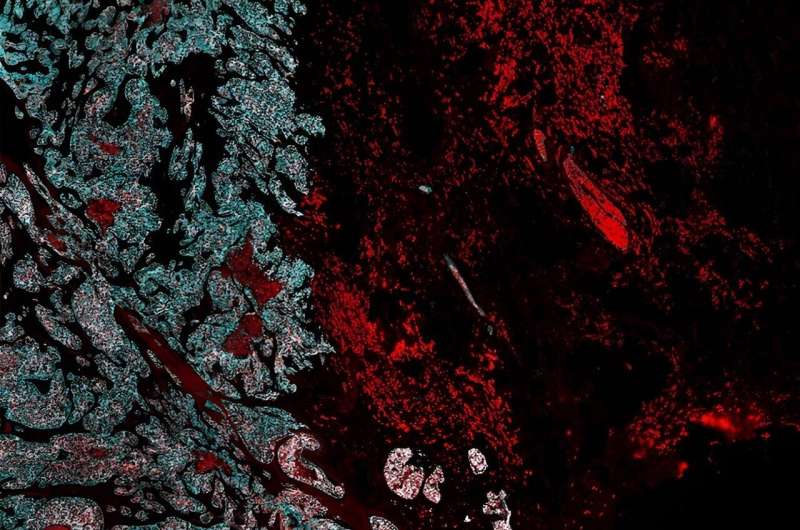This article has been reviewed according to Science X's editorial process and policies. Editors have highlighted the following attributes while ensuring the content's credibility:
fact-checked
peer-reviewed publication
trusted source
proofread
When tumors collide: Analysis of mixed-type breast cancer reveals complexity

As part of a breast cancer diagnosis, pathologists take cells from a biopsy and check them under a microscope. Most cancerous cells form roundish clumps, known as no special type, or invasive ductal carcinoma (IDC). In fewer patients, the abnormal cells are more dispersed, growing as spider web-like tendrils throughout the breast tissue.
These are invasive lobular carcinomas (ILC). In very rare cases, IDC and ILC occur together as mixed ductal-lobular breast cancer (MDLC), which occur as collision type, where IDC and ILC cells grow in distinct regions, eventually colliding, or intermingled type, in which the cells are mixed.
These complex MDLC tumors are difficult to define and have not been well studied, so there is little understanding of the molecular features and best approaches for treatment, according to Steffi Oesterreich, Ph.D., professor in the Department of Pharmacology and Chemical Biology at Pitt and co-leader of the Cancer Biology Program at UPMC Hillman Cancer Center.
When Oesterreich and her team, which included researchers from the University of Michigan and Memorial Sloan Kettering Cancer Center, analyzed collision-type MDLC tumors, they found that IDC and ILC regions had distinct molecular features, shedding new light on the complexity of these tumors, and suggesting that different treatment approaches could be warranted.
The findings are published in PNAS.
"We found that the different regions of mixed tumors had very different underlying biology," said Oesterreich, who is also the co-director and director of education at the Women's Cancer Research Center of Magee-Womens Research Institute and UPMC Hillman. "These patients essentially have two independent diseases that may respond differently to different treatments."
For the study, the researchers identified three breast cancer cases that three pathologists agreed were MDLC. Then they used novel spatial sequencing technology that compares gene expression in different regions of the tumor. They also performed a mutation analysis to identify alterations in the DNA sequences of tumor cells across the tumor.
They found that the IDC and ILC regions of the tumors had very different gene expression profiles, or transcriptomes.
"In one of the cases, we found very different molecular subtypes in different regions of the tumor," said Oesterreich. "One is what we call luminal, and the other was triple-negative. These molecular subtypes are treated very differently. Our findings suggest that spatial sequencing of mixed-type breast cancers could inform different therapies for patients."
Another key finding was that all three cases had distinct molecular features.
"It was surprising, almost shocking, that the three cases of MDLC were so different," said Oesterreich. "Our study reveals tremendous variation within this already highly variable disease."
While genetic sequencing is a routine part of cancer care, current approaches do not account for variation across the tumor. In the future, spatial sequencing could be combined with other technology such as single cell sequencing to provide a nuanced picture of mixed tumors to guide personalized treatments that target this complexity.
Oesterreich hopes that this study raises awareness of the potential clinical implications of mixed breast cancers and spurs additional research to understand more about this understudied disease and optimal treatment approaches.
More information: Osama Shiraz Shah et al, Spatial molecular profiling of mixed invasive ductal and lobular breast cancers reveals heterogeneity in intrinsic molecular subtypes, oncogenic signatures, and mutations, Proceedings of the National Academy of Sciences (2024). DOI: 10.1073/pnas.2322068121




















